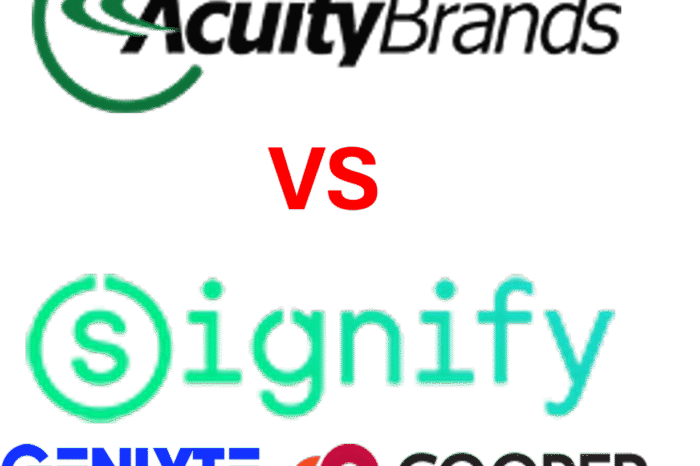Acuity Lights Up CYQ3; Shares 2019 Market Outlook
 Acuity recently shared its Q3 sales and earnings performance and the highlight numbers were record fourth quarter and full-year results for net sales, net income, and diluted earnings per share albeit there were some interesting underlying concerns that shed light on the ongoing competitiveness within the lighting industry.
Acuity recently shared its Q3 sales and earnings performance and the highlight numbers were record fourth quarter and full-year results for net sales, net income, and diluted earnings per share albeit there were some interesting underlying concerns that shed light on the ongoing competitiveness within the lighting industry.
From the earnings call:
- While record results for their Q4 and fiscal year “had higher expectations for 2018.”
- Market conditions “subdued” for larger commercial projects (which is Acuity’s sweet spot and an area identified as “slow growth” for electrical distributors in our Q3 2018 Pulse of Lighting survey which was released prior to the call.)
- Net sales almost $1.1 billion for Q4, up 11% with adjusted operating profit of $154 million for an operating profit margin of 14.5%, down 390 basis points!
- Full year sales were $3.7 billion, up 5%
- Deflationary pricing continued with cost pressures more significant than forecast … and in the 4th quarter (results of competition, overseas imports, aluminum and steel tariffs which increased costs, increased freight costs and then the recent lighting and LED tariffs … but these affect all lighting competitors as they are the realities of the lighting market. Price erosion has abated somewhat. Other than tariffs changing, these market forces will continue. A change for Acuity is their increased desire to compete, and retake share, in the small to mid-sized contractor market which is small to mid-sized projects – new and renovation – as well as some stock business. They, and others, want to compete where the market has been strongest, and the most competitive.)
- They made 2 acquisitions during the year and with a new $800 million five year credit facility, are probably looking to continue on the acquisition trail.
- Net sales volume was up 13%, the question becomes, through what channels and in which product “tiers”?
- 3 points were price and mix of business sold, acquisitions and foreign currency (so, then down to 10%).
- “Expanded” its customer base (selling to more electrical distributors or selling through other channels, inclusive of direct / through ESCOs as well as to municipalities (which they reported a significant sale to this market in their Q3 (springtime)).
- Had greater shipments of “more basic, lesser-featured LED fixtures” (their Contractor Select line which is a “contractor-grade” offering with lower margins. This begs the question of “are they having accelerated success in distributors moving share to them? Distributors, please let us know. Feedback in our survey indicated that the lighting conglomerates are seeking to leverage distributors but a significant majority did not feel this would be very effective.)
- “Greater shipments of certain high volume, more basic, lesser-featured LED fixtures for applications on smaller commercial and residential projects (which is presumably the Contractor Select offering)
- Sold more Atrius-based luminaires (which last quarter they stated that these, since they are for projects, are at lower margins)
- Growth in infrastructure and utility channels via Holophone offering (direct sales … no distributor involved)
- And it is interesting that on a “how to buy” page on Acuity’s site it promotes contacting agents, purchasing via retail and online sources (but no electrical distributors) and then connecting to some brands that more regularly sell direct. There doesn’t appear to be an option to learn which distributors support Acuity.
- Retail sales
Many of the areas of sales growth (especially the last 3 or 4) are lower margin offerings / channels, which are the longer-term growth areas and may infer lower overall margins for Acuity going further (perhaps the same as the quarter, perhaps slightly lower unless Acuity added to its margin in its latest price increase that was instituted “due to tariffs.”
- Acuity believes it has gained market share (our research shows that the 7 large lighting companies continue to lose share amongst our survey respondents, however, Acuity could gain at the expense of the other six.)
- Sales through C&I channel (distributors) down again in dollars … hence now less than 60% of sales (which correlates to our survey showing the 7 large lighting companies representing only 55% of distributor lighting sales … inclusive of lamps and controls. So, is another channel increasing in importance to Acuity or is “direct” a greater influence? Which channel is more profitable … gross margin and net profit … to Acuity?)
- While Acuity is utilizing some data showing that the overall North American market (hence including Canada and theoretically Mexico, perhaps NEMA data which is multi-channel? Or maybe Epicor’s Vista Information Services, which is focused on the electrical distribution market), they believe that the lighting margin has been flat to down. While this may be true multi-channel, our survey shows the electrical distribution market is up about 5%.
- Adjusted gross margin profit down to 39%, a decrease of 350 basis points. (Given the changing product mix and channel diversity, this may become the norm, or maybe a high, unless Acuity makes other changes to its operations.)
- Expect some continued “drag” on margins due to tariffs and increased costs in their Q1 (fall). (Some of this is probably due to commercial reasons such as committed quotes for projects as well as the need to provide 30-90 days advanced notice to selected distributors for price increases.)
- Tier 3 and 4 products are now 15% of sales (… so $150 million or so in the recent quarter, theoretically $555 million. It will be interesting to learn the margin for these products as the positioning is that these are IoT related and due to software and controls should be higher margin, however, Acuity has indicated due to the bulk (quantity) sale of these fixtures, and direct sales nature, the fixture gross margin is lower. It remains to be seen if they can monetize the software and the data.)
- Interesting that Acuity is now commenting on / accepting the competitiveness of “Chinese-based” lighting companies. (It also then begs the question of “Does Acuity source any lighting – complete fixtures and/or components – from China and/or perhaps from some of the same companies?” Can’t have the “pot calling the kettle black”. And this is not a new phenomenon.)
- Acuity states that they import 15% of finished goods from China and are seeking alternatives. And that they “primarily manufacturer in North America”. (Given this, their price increase could be less than many others, if they desire, to help them be more price competitive to retake share from competitors … and even more competitive if additional tariffs are levied in January. Question to distributors … are they more price competitive? Did they have a price increase in October … broad-based or very selected SKUs?)
- Hence they are recouping costs beyond tariffs with recent price increases, which could defeat the challenge of being more price competitive? Time will tell if they are able to retake significant share with Contractor Select.
- Tariffs shouldn’t have much of a benefit, or affect, on Acuity with souring only being 15% of finished goods.
- And if it goes to 25%, the incremental 15% should only be on 15% of Acuity’s sales
- Interest their wireless control system nLight AIR. (Distributors and lighting specialists – how does this compare vs Lutron? Other competitors?)
- Looking towards 2019 …
- Expect construction market to grow in low to mid-single digits
- Lighting industry to lag overall construction market growth due to product substitution to lower-priced alternatives (which means they need to sell more Contractor Select products and infers that many customers don’t feel a compelling reason to upgrade to more robust offerings / IoT offerings.)
- Expect market to remain price competitive (which probably means that Acuity’s margins won’t change, perhaps decline, and that distributors should plan for their only pricing benefit to come from manufacturer price increases, if any … so, need to sell more units for same sales and GP$)
- Tight labor markets, which may continue to constrain construction project implementation.
- Tariffs … who knows!
- Overall, 2019 lighting market projected at low single digits.
- Continuing commodity cost increases, which could be inflationary in nature.
- Expect increased Tier 3 and 4 product category sales (which appear to be project-oriented)
- To improve company margins, Acuity needs share increases in the C&I channel. A combination of more large projects and retaking share in lesser-featured SKUs.
- Data optimization (and IoT) still in “early stages”, so having much slower adoption and revenue realization than expected.
- Tariffs shouldn’t have much of a benefit, or affect, on Acuity with souring only being 15% of finished goods.
- Hence they are recouping costs beyond tariffs with recent price increases, which could defeat the challenge of being more price competitive? Time will tell if they are able to retake significant share with Contractor Select.
- Acuity states that they import 15% of finished goods from China and are seeking alternatives. And that they “primarily manufacturer in North America”. (Given this, their price increase could be less than many others, if they desire, to help them be more price competitive to retake share from competitors … and even more competitive if additional tariffs are levied in January. Question to distributors … are they more price competitive? Did they have a price increase in October … broad-based or very selected SKUs?)
From analyst questions:
- Saw some increase in inventory. Probably due to launching Contractor Select offering. Perhaps for pre-staging for Atrius projects.
- Inventory grew 25% which then suggests “if this is Contractor Select products, to achieve its goals, Acuity needs to significantly increase sales, and share, in the C&I channel and/or the home center channel as these are the targets for this offering.” If it is not as successful as planned, how quickly will the inventory be devalued as its features will lag the market.
- Tier 3 and 4 growth rate ranges from 25-40% as it is “lumpy” due to being project-oriented. In last quarter was up 25%, and would have represented 17-18% of quarterly sales.
Achieving Success
To achieve its goals Acuity needs at least two of the following three things to happen:
- Growth in large projects and/OR large Atrius projects be captured through “other channels” / direct
- Its Contractor Select offering to gain significant traction, enabling it to take share in the C&I market
Achieving this may mean that:
- Acuity lighting agents will need to be more prevalent at distributor locations
- Acuity increases its share in the C&I space
- Acuity successful sells, or leverages, its Contractor Select offering to distributors to increase stock position and/or influence branch level sales … and be price competitive so contractors say “yes” to the offering.
While appears to have been a productive quarter, it does highlight the challenges of being in the lighting industry.
Question
Competitors, distributors and lighting agents … how are you viewing Acuity? The lighting market? And what are your early thoughts re 2019?























